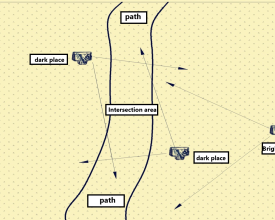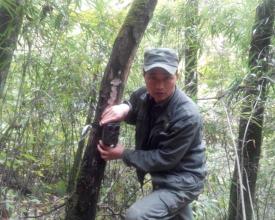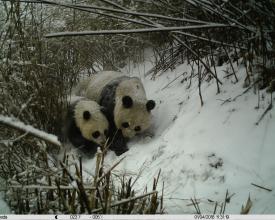
Mesures de gestion efficaces pour le suivi dynamique de la gestion et de la protection des ressources dans la réserve naturelle nationale de Shaanxi Changqing

La réserve naturelle de Changqing est située dans le comté de Yangxian, sur le versant sud de la partie moyenne des montagnes Qinling, qui se trouve également à la source de la rivière Youshui, un affluent de la rivière Han, et est adjacente à 9 villages administratifs. La situation de la communauté est complexe et des activités humaines s'y déroulent de temps à autre. Afin d'améliorer cette situation, depuis 2014, la réserve a appliqué de manière innovante des caméras à infrarouge lointain à la gestion et à la protection des ressources, et les a combinées avec des visites communautaires, des inspections quotidiennes, la publicité des lois et règlements, l'introduction de projets, etc., ce qui a considérablement réduit la fréquence de l'accès humain à la réserve dans la communauté, assuré la sécurité des ressources animales et végétales sauvages dans la juridiction, et également atténué les conflits entre les communautés et les zones protégées.
Contexte
Défis à relever
- La mise en œuvre du projet nécessite le soutien durable de fonds spéciaux ;
- Il existe un certain conflit d'intérêts avec la communauté, qui risque d'endommager et de perdre l'appareil photo ;
- Le braconnage, qui peut détruire l'habitat de la faune.
Emplacement
Traiter
Résumé du processus
Le fonctionnement entre les modules est très simple. La première étape consiste à collecter l'influence de l'interférence humaine à l'aide de la technologie de la caméra infrarouge. La deuxième étape consiste à charger une personne spécifique d'identifier et de classer les données d'image collectées. La troisième étape consiste à effectuer le travail sur la base des informations identifiées sur l'interférence humaine. Grâce à l'accumulation de données sur une longue période, nous pouvons déterminer les principales zones protégées et les personnes présentes dans la réserve afin de guider la sélection et l'emplacement des sites de caméra lors de la première étape, ce qui la rend plus scientifique et plus ciblée. Les trois sont étroitement liés, interagissent et se complètent, ce qui constitue une mesure de gestion de la protection très efficace. Elle peut non seulement améliorer l'efficacité de la conservation, mais aussi réduire de manière significative la fréquence des activités humaines, de sorte que l'on peut dire qu'elle est très populaire et opérationnelle.
Blocs de construction
Disposition des caméras et collecte des données
En tenant compte des caractéristiques géographiques de la réserve, des caractéristiques saisonnières, de la répartition des communautés et des principales ressources naturelles, les travailleurs de terrain mettent en place des sites de surveillance sur les routes principales et à l'entrée des ravins de la région, et utilisent la méthode "deux caméras lumineuses et une caméra sombre" pour le déploiement des caméras, c'est-à-dire que les deux caméras tiennent compte de l'orientation de l'objectif, de la distance, Les deux caméras tiennent compte de l'orientation de l'objectif, de la distance et de la qualité des images pour s'assurer que des images ou des vidéos claires de l'avant de l'entrant sont prises sans laisser de zones mortes dans la zone aveugle, et la troisième caméra se concentre sur la sécurité des deux premières caméras, placées dans un endroit très secret et difficile à trouver, et le champ visuel doit inclure les deux premières caméras infrarouges pour éviter les dommages malveillants à l'équipement de surveillance, sinon, les données seront perdues.
Facteurs favorables
La première est que l'installateur de la caméra maîtrise la disposition des caméras infrarouges, la deuxième est que le site d'installation de la caméra peut être sélectionné correctement, la troisième est que le plan de travail est combiné avec la situation réelle, et la quatrième est le mécanisme de récompense et de punition correspondant.
Leçon apprise
Premièrement, les paramètres, l'orientation et la hauteur de l'appareil photo doivent être corrects afin de réduire le nombre de photos non valides. Deuxièmement, l'appareil photo doit être placé dans un endroit bien caché afin de réduire le taux de perte de l'appareil.
Récupération et identification des données
Le bureau d'administration charge les employés de bureau d'identifier, de classer et de saisir les données en fonction du personnel, des informations sur les activités humaines et des informations sur les ressources animales. Les employés de bureau distinguent les photos des activités humaines et déterminent les informations spécifiques du personnel (personnel communautaire ou non).
Facteurs favorables
1. Recycler et évaluer les données des caméras en temps voulu, conformément au plan.
2. Entretenir régulièrement l'équipement.
3. L'identification des données des caméras doit être unifiée.
4. Effectuer immédiatement des travaux de suivi pour les activités humaines découvertes.
5. Mécanismes de récompense et de punition correspondants.
Leçon apprise
1. Numérotez uniformément les cartes de données de l'appareil photo afin d'éviter toute confusion.
2. Remplacer les caméras défectueuses en temps utile.
3. Prévoir du personnel fixe pour identifier les données.
Visites à la communauté et éducation
Viser l'information sur les interférences humaines et organiser en temps utile le personnel de gestion et de protection pour effectuer des visites de la communauté, des inspections spéciales, etc. Pour les personnes impliquées, nous pouvons fournir des avertissements verbaux, des avertissements légaux et de l'éducation, ainsi qu'un enregistrement conformément au "Règlement sur la gestion des réserves naturelles".
Facteurs favorables
Selon les informations identifiées, le travail de suivi a été effectué en temps voulu, et les principales zones de gestion et les principaux groupes de gestion ont été établis, ce qui nous permet, à long terme, de présenter des projets à la communauté et d'augmenter ses revenus.
Leçon apprise
La combinaison de plusieurs années de données peut être représentative et référentielle. Lors du lancement d'une éducation à l'alerte, nous devrions prêter attention aux méthodes et aux moyens de réduire les conflits d'intérêts et d'améliorer la sensibilisation à la protection des ressources.
Impacts
- La sensibilisation de la communauté à la protection des ressources a été améliorée, de même que l'utilisation traditionnelle et la dépendance à l'égard des ressources naturelles ;
- Les méthodes de gestion des ressources dans la réserve sont plus efficaces, ce qui permet de mieux protéger les ressources de la zone, et les informations sur les personnes qui ont pénétré illégalement dans la zone ont été contrôlées, ce qui permet d'obtenir des preuves objectives et précises pour l'application de la législation administrative forestière ;
- économiser de la main d'œuvre et des ressources financières, et réduire le coût de la conservation des ressources.
Bénéficiaires
- Autorités chargées de la faune et de la flore
- Communautés locales
- Les défenseurs de l'environnement
Objectifs de développement durable
Histoire
Baiyangping appartient à la zone centrale de la réserve naturelle de Changqing, dans la province de Shaanxi, et c'est l'une des zones où l'on rencontre le plus souvent des pandas géants sauvages en Chine. Il s'agit également d'une zone clé pour la surveillance dynamique des activités humaines par des caméras infrarouges dans le cadre de la protection du panda géant dans la réserve naturelle de Changqing. L'utilisation de caméras selfie déclenchées par infrarouge pour la surveillance dynamique des activités humaines a permis de recueillir efficacement des informations sur les activités humaines et de réprimer le braconnage illégal d'animaux et de plantes sauvages. Par conséquent, ces caméras sont devenues l'œil de faucon de la réserve, les gardiens du jour et de la nuit.
L'été dernier, nous avons installé un groupe de caméras infrarouges sur les routes principales de la région de Baiyangping. Les trois caméras ont été placées à des endroits différents pour se compléter et se surveiller. La surveillance a révélé que Zhang Moumou, un villageois de la communauté de Banqiao, et trois voisins avaient pénétré illégalement dans la zone protégée pour y extraire des substances médicinales chinoises. Zhang Moumou a trouvé une caméra infrarouge. Craignant que leurs activités illégales ne soient révélées au grand jour, ils ont emporté la caméra dans la rivière pour l'enterrer, mais ils ne s'attendaient pas à ce qu'une autre caméra infrarouge filme discrètement leurs activités sur des photos et des vidéos. Par la suite, nous avons retrouvé Zhang Moumou grâce aux données vidéo et audio des deux autres caméras. Au début, il a refusé d'admettre son comportement illégal. Après que nous lui avons présenté les preuves vidéo et audio capturées par la caméra infrarouge, il a immédiatement avoué son comportement illégal et déclaré qu'il le regrettait sincèrement. Il s'est rendu sur le site pour identifier la scène et a activement déterré la caméra infrarouge enterrée. Ils se sont excusés par écrit et se sont engagés à étudier les lois et règlements relatifs à la protection des espèces sauvages à l'avenir et à soutenir la protection et la gestion des zones protégées.
Ce cas a bien joué son rôle d'avertissement et d'éducation dans la communauté locale, ce qui a permis de sensibiliser les résidents de la communauté à l'état de droit, de montrer aux employés l'image de la gestion et de la protection scientifiques, de l'application de la loi et de l'équité dans l'application de la loi dans la réserve, et de mettre en évidence l'effet de la surveillance dynamique des activités humaines à l'aide de caméras infrarouges, promouvant ainsi puissamment la protection et la gestion des ressources dans la réserve.



